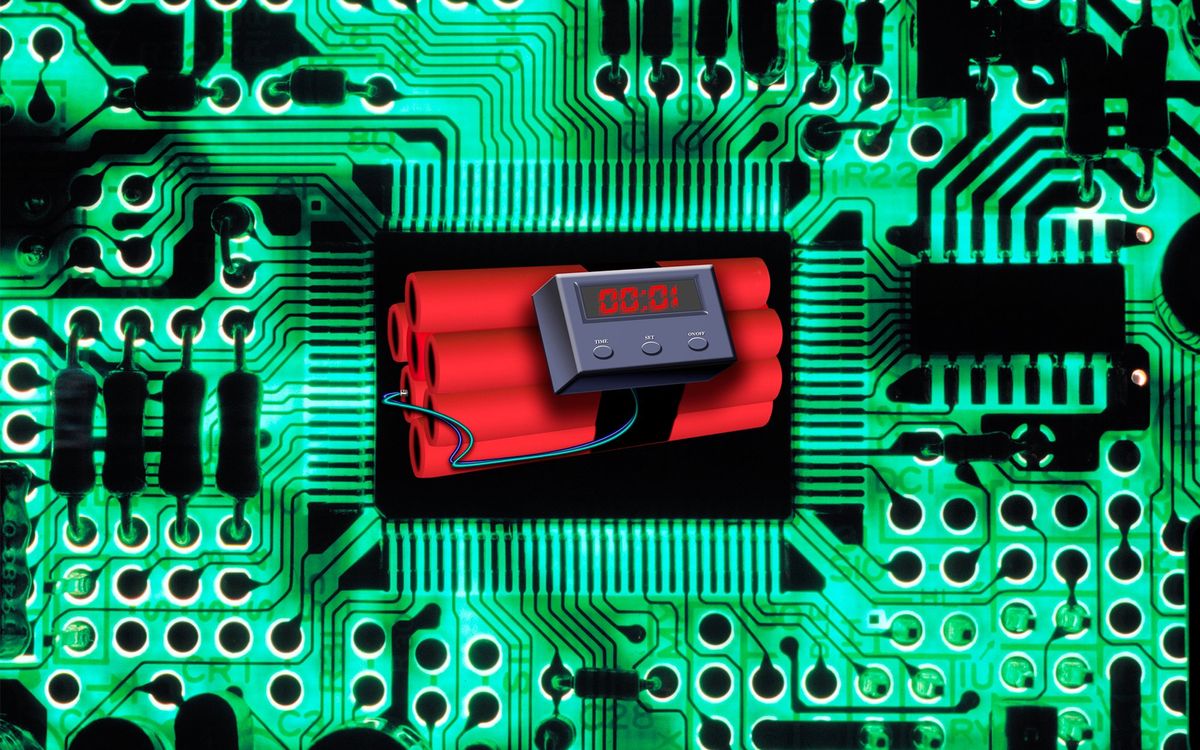Last week at the IEEE International Solid-State Circuits Conference (ISSCC), researchers introduced several technologies to fight even the sneakiest hack attacks. Engineers invented a way to detect a hacker placing a probe on the circuit board to attempt to read digital traffic in a computer. Other researchers invented new ways to obfuscate electromagnetic emissions radiating from an active processor that might reveal its secrets. Still other groups created new ways for chips to generate their own unique digital fingerprints, ensuring their authenticity. And if even those are compromised, one team came up with a chip-fingerprint self-destruct scheme.
A Probe-Attack Alarm
Some of the most difficult-to-defend-against attacks involve when a hacker has physical access to a system’s circuit board and can put a probe at various points. A probe attack in the right place can not only steal critical information and monitor traffic. It can also take over the whole system.
“It can be a starting point of some dangerous attacks,” Mao Li, a student in Mingoo Seok’s lab at Columbia University, told engineers at ISSCC.
The Columbia team, which included Intel director of circuit technology research Vivek De, invented a circuit that’s attached to the printed-circuit-board traces that link a processor to its memory. Called PACTOR, the circuit periodically scans for the telltale sign of a probe being touched to the interconnect—a change in capacitance that can be as small as 0.5 picofarads. If it picks up that signal, it engages what Lao called a protection engine, logic that can guard against the attack by, for example, instructing the processor to encrypt its data traffic.
Triggering defenses rather than having those defenses constantly engaged could have benefits for a computer’s performance, Li contended. “In comparison to…always-on protection, the detection-driven protection incurs less delay and less energy overhead,” he said.
The initial circuit was sensitive to temperature, something a skilled attacker could exploit. At high temperatures, the circuit would put up false alarms, and below room temperature, it would miss real attacks. The team solved this by adding a temperature-sensing circuit that sets a different threshold for the probe-sensing circuit depending on which side of room temperature the system is on.
Electromagnetic Assault
“Security-critical circuit modules may leak sensitive information through side channels such as power and [electromagnetic] emission. And attackers may exploit these side channels to gain access to sensitive information,” said Sirish Oruganti a doctoral student at the University of Texas at Austin.
For, example, hackers aware of the timing of a key computation, SMA, in the AES encryption process can glean secrets from a chip. Oruganti and colleagues at UT Austin and at Intel came up with a new way to counter that theft by obscuring those signals.
One innovation was to take SMA and break it into four parallel steps. Then the timing of each substep was shifted slightly, blurring the side-channel signals. Another was to insert what Oruganti called tunable replica circuits. These are designed to mimic the observable side-channel signal of the SMAs. The tunable replica circuits operate for a realistic but random amount of time, obscuring the real signal from any eavesdropping attackers.
Using an electromagnetic scanner fine enough to discern signals from different parts of an IC, the Texas and Intel team was unable to crack the key in their test chip, even after 40 million attempts. It generally took only about 500 tries to grab the key from an unprotected version of the chip.
This Circuit Will Self-Destruct in…
Physically unclonable functions, or PUFs, exploit tiny differences in the electronic characteristics of individual transistors to create a unique code that can act like a digital fingerprint for each chip. A University of Vermont team led by professor Tian Xia and involving Marvell Technology took its PUF a step farther. If it’s somehow compromised, this PUF can actually destroy itself. It’s extra-thorough at it, too; the system uses not one but two methods of circuit suicide.
Both stem from pumping up the voltage in the lines connecting to the encryption key’s bit-generating circuits. One effect is to boost in current in the circuit’s longest interconnects. That leads to electromigration, a phenomenon where current in very narrow interconnects literally blows metal atoms out of place, leading to voids and open circuits.
The second method relies on the increased voltage’s effect on a transistor’s gate dielectric, a tiny piece of insulation crucial to the ability to turn transistors on and off. In the advanced chipmaking technology that Xia’s team uses, transistors are built to operate at less than 1 volt, but the self-destruct method subjects them to 2.5 V. Essentially, this accelerates an aging effect called time-dependent dielectric breakdown, which results in short circuits across the gate dielectric that kill the device.
Xia’s doctoral student and Marvell Technology senior staff manager Eric Hunt-Schroeder was motivated to make these key-murdering circuits by reports that researchers had been able to clone SRAM-based PUFs using a scanning electron microscope, he said. Such a self-destruct system could also prevent counterfeit chips entering the market, Hunt-Schroeder said. “When you’re done with a part, it’s destroyed in a way that renders it useless.”
This post was corrected on 2 April to clarify who led the research at University of Vermont.
Samuel K. Moore is the senior editor at IEEE Spectrum in charge of semiconductors coverage. An IEEE member, he has a bachelor's degree in biomedical engineering from Brown University and a master's degree in journalism from New York University.



